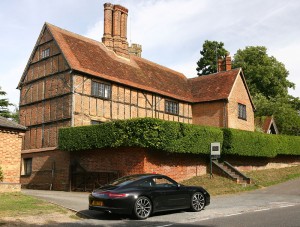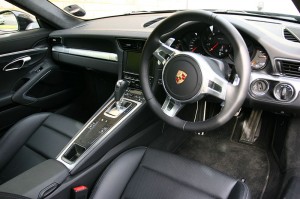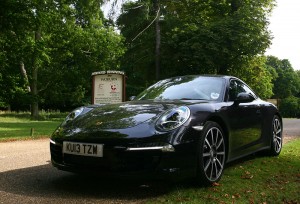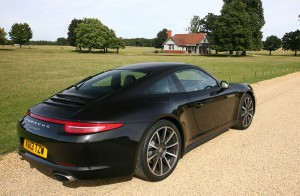I was recently privileged to borrow a demonstrator Basalt black 991 Carrera 4 from OPC Silverstone in Towcester for four days to take me to our race meeting at Oulton Park.
The Carrera 4 is a rarely-specified variant of the extensive 991 range, adding 4-wheel-drive to the base model. You can imagine that, fitted with a set of winter tyres (such as Pirelli’s Sotozero), this car would do as well on snowy and icy roads as many so-called “sports utility vehicles” (which often don’t even have a 4WD mode). The penalty of the added traction is a slight loss of front boot storage space, but with it comes some added weight which I’m certain benefits front-end grip. Pushing on around the country lanes around Woburn, I felt none of the uncertainly that appeared to be present in the 997 Gen 2 (at least with a standard geo) – turn-in was sharp and precise and it was extremely easy to forget that the car is equipped with electronic steering.
Built as a dealer demonstrator, this car came with an array of impressive gadgetry, some of which I’d never encountered in a Porsche before. Auto dimming mirrors preserved my night vision on the journey home; all-round parking sensors helped me avoid the hedges in the narrow back lanes around the Oulton Park circuit and for parking in Tarporley town centre. Cruise control took some of the strain out of the long motorway journey, but this system appears to be more intelligent than most , allowing some variance in actual road speed as the car transitioned to a slope – which I’m sure aided the economy still further. I also liked the indicator feature where a quick flick of the lever would give me three flashes for lane changing. The integrated PCM audio and satellite navigation is a step up from previous systems and addresses most of the often-criticized issues of the systems that Porsche has employed in the past.
Economy has never really featured as a selling point for the 911 but this latest car returns impressive figures. During my mostly motorway journey north, I watched the data display (right-most dial) as the mpg figure steadily rose to peak at a very impressive 34.7 by the time I left the M6 at J18. To further reduce emissions, PDK cars now come with a feature which actually turns off the engine when coasting or when stationary for more than a very short period. I personally found this activity very disconcerting and switched it off once I’d tried it a few times (Sport mode automatically turns off this feature).
Economy however comes at the cost of performance and if you’re hoping for a kick-in-the-pants experience, you are going to need to look at the 3.8 litre engine variants of the 991 range. As part of Porsche’s economy drive, the “base” Carrera engine capacity has been dropped from 3.6 in the 997 to 3.4 for the new model, so the capacity is now the same as the S variant of the Boxster (even though it’s not actually the same unit). Admittedly in the Carrera an extra 35hp is extracted from the DFi engine at a higher 7400rpm, but this means that you have to “wring its neck” to reach the power band which is an activity the PDK’s computer is certainly not prepared to entertain in ‘D’ mode – even when you have activated the now-standard Sport button. Only once did I literally “floor it”, to overtake an uncharacteristically slow Golf GTi on the A54. The PDK box dropped not just one or two, but three gears, accompanied by a satisfying howl from the exhaust – but obviously this only began to happen once I had started the manoeuvre. Even though its changes are incredibly fast, I would recommend that instead of relying on the box to do all the shifting for you, in overtaking situations like this you make at least one downshift manually before beginning any steering input. If you fancy more driver involvement, it’s easy to switch PDK to manual and use either a sequential shift approach or use the on-wheel paddles to change up and down.
There are some niggles with the car. This one came with the still-optional paddle shift SportDesign steering wheel, and combined with the four control stalks, it’s easy to lose sight of some of the instrumentation, particularly the fuel gauge which sits bottom-right of the cluster.
Whilst the optional Sports seats do a great job of holding you in place sideways, there is a lack of lumbar support which gave me a little back ache after the long journey. If you have back problems, you might consider the new “Adaptive sports seats plus” instead.
Overall, this latest incarnation of the legendary 911 left me rather more impressed than I have been with earlier versions. I think Porsche have really “re-invented” the concept this time around – the 991 represents more of a step forward than the transition from 996 to 997. Their extensive use of aluminium in the body, as well as the slight changes to chassis and engine positioning, have made the car much more sure-footed on the road. At the same time, the new technology that has had many a motoring journalist worried (particularly the electronic steering), has not detracted from the driving experience.
The figures:
- power: 350 hp at 7,400 rpm
- acceleration: 0-62 mph in 4.7 s
- top speed: 177 mph
- combined fuel consumption: 30.4 mpg
- CO2 emissions: 219 g/km
I am indebted to Robin Simpson, Dealer Principal of OPC Silverstone for the loan of this magnificent machine.





